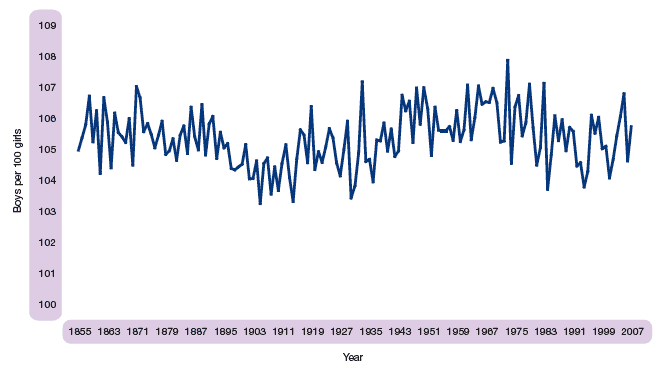
Introduction
The Births section of Chapter 1 discussed the trend in fertility rates over the past 50 years. The main points include:
This chapter considers the effect of social factors on fertility and gives some comparisons with other parts of the UK and selected other countries.
Mother’s country of birth
In 2007, 78 per cent of births were to mothers born in Scotland and around 9 per cent were to mothers born in England. Table 2.1 shows the number of births by country of mother’s birth over the past 30 years.
Table 2.1 Births, by country of mother’s birth, selected years
Mother's country of birth |
Year |
|||||||||
|---|---|---|---|---|---|---|---|---|---|---|
1977 |
1987 |
1997 |
2004 |
2007 |
||||||
Number |
% |
Number |
% |
Number |
% |
Number |
% |
Number |
% |
|
All births |
62,342 |
|
66,241 |
|
59,440 |
|
53,957 |
|
57,781 |
|
Scotland |
54,305 |
87.1% |
57,064 |
86.1% |
49,908 |
84.0% |
43,813 |
81.2% |
45,328 |
78.4% |
England |
4,683 |
7.5% |
5,376 |
8.1% |
5,676 |
9.5% |
5,221 |
9.7% |
5,328 |
9.2% |
Poland |
18 |
0.0% |
8 |
0.0% |
11 |
0.0% |
31 |
0.1% |
934 |
1.6% |
Pakistan |
324 |
0.5% |
531 |
0.8% |
480 |
0.8% |
558 |
1.0% |
641 |
1.1% |
Northern Ireland |
416 |
0.7% |
365 |
0.6% |
394 |
0.7% |
493 |
0.9% |
536 |
0.9% |
Germany |
121 |
0.2% |
240 |
0.4% |
369 |
0.6% |
385 |
0.7% |
397 |
0.7% |
India |
213 |
0.3% |
168 |
0.3% |
112 |
0.2% |
201 |
0.4% |
324 |
0.6% |
Ireland |
464 |
0.7% |
247 |
0.4% |
214 |
0.4% |
230 |
0.4% |
303 |
0.5% |
Other countries – each less than 0.5% of total births in 2007 |
1,798 |
2.9% |
2,242 |
3.4% |
2,276 |
3.8% |
3,025 |
5.6% |
3,990 |
6.9% |
Since 2004, the number of births has increased by 3,824. Scots-born mothers accounted for 1,515 (or 40%) of that increase, and other UK-born mothers for a further 184 (or 5% of the increase). Polish-born mothers contributed 903 extra births (or 24% of the increase) and mothers born in the other nine countries which joined the EU in 2004 a further 233 extra births (or 6% of the increase). There were an extra 156 babies (4% of the total increase) born to mothers from the remaining EU countries and 833 (22% of the total increase) to mothers from the rest of the world.
Sex ratio at birth
It is a well established fact that in virtually all countries and societies more boys are born than girls. Though many theories have been advanced, there is no single scientific explanation for this phenomenon. Rather, it is believed to be the complex result of a range of different biological factors. The records held by the Registrar General show that, over the past 150 years, the sex ratio at birth in Scotland has been just under 106 boys for every 100 girls. The ratio in 2007 was 105.7 while the lowest ratio recorded was 103.2 in 1905 and the highest was 107.9 in 1973. However, Figure 2.1 shows that, as well as the expected random year to year fluctuations, there appears to have been a long-term period of increase from early in the twentieth century to the mid-1970s and a slight decrease since then. A similar long-term increase was observed in England.
Figure 2.1 Sex ratio at birth, Scotland, 1855-2007

Multiple births
The proportion of maternities in Scotland resulting in multiple births has remained relatively constant at just over 1 per cent throughout the last 150 years (Figure 2.2). Though the five-year average dipped below 1 per cent in the late 1970s, it has subsequently risen to its highest ever level at just over 1.5 per cent, possibly associated with the increasing availability of fertility treatment involving the implantation of more than one egg. On average, just over 1 per cent of multiple births have involved triplets or higher order multiples. The actual numbers of such births peaked in 1995 at 30. Since then the number has fallen back substantially, perhaps because of changes in fertility treatment.
Figure 2.2 Multiple births, number and percentage of maternities, Scotland, 1855-2005
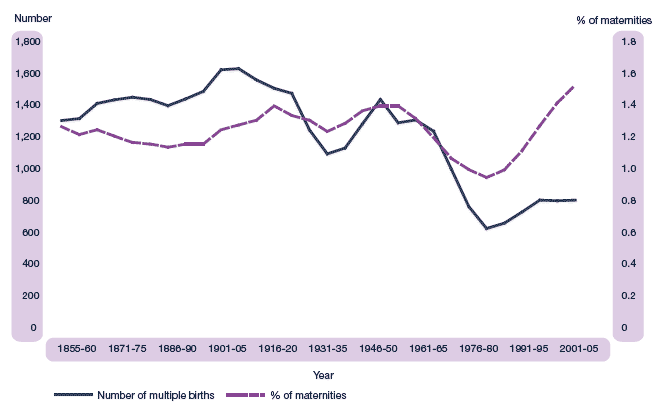
Marital status of parents
Information collected on the marital status of parents when registering a birth provides an insight into changing social attitudes. Figure 2.3 shows the percentage of children born to unmarried parents since the introduction of civil registration. The first hundred years show a gradual decline from around 10 per cent in the 1860s to 4 per cent in the late 1950s. Since the 1960s, the proportion has increased steeply to the point where almost half of all children are born to unmarried parents.
Figure 2.3 Percentage of children born to unmarried parents, Scotland, 1855-2007
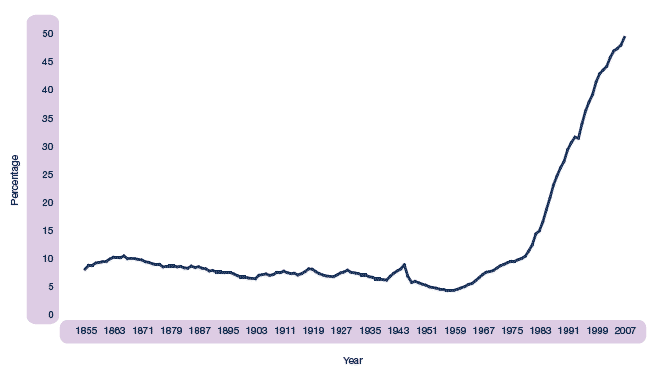
Figure 2.4 shows more detail on the marital status of parents over the past thirty years. In 2007, 51 per cent of births were to married parents, compared to 62 per cent ten years earlier and 90 per cent in 1977. However, the proportion of births registered solely in the mother’s name has remained relatively constant between 5 and 7 per cent. The proportion of births to unmarried parents, which were jointly registered by the mother and father, has increased significantly to 32 per cent suggesting that the increase in births to unmarried parents has been in babies born to partners who are in a stable relationship.
Figure 2.4 Percentage of births by marital status and type of registration, Scotland, 1977-2007
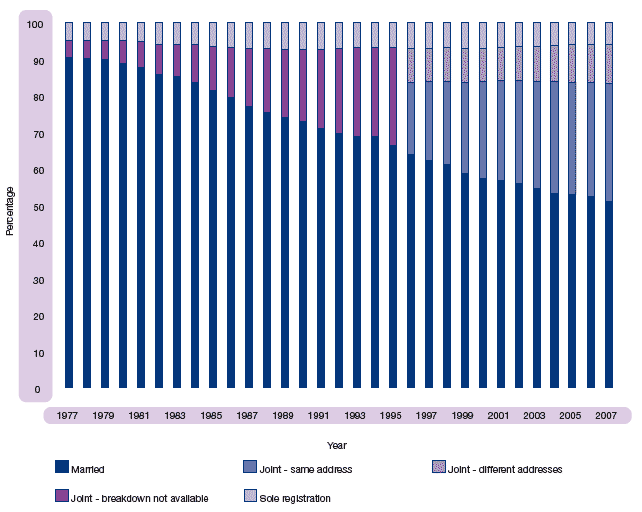
Socio-economic class
Figure 2.5 shows how the age profile of mothers in 2007 varied significantly by socio-economic class (as defined by occupation). For those allocated to ‘managerial and professional’ categories there was a particularly marked peak of childbearing in the 30-34 age group. By comparison, the peak childbearing age for those in ‘routine’ and ‘semi-routine’ categories was 20-24.
Figure 2.5 Percentage of births by age group, by socio-economic class, Scotland, 2007
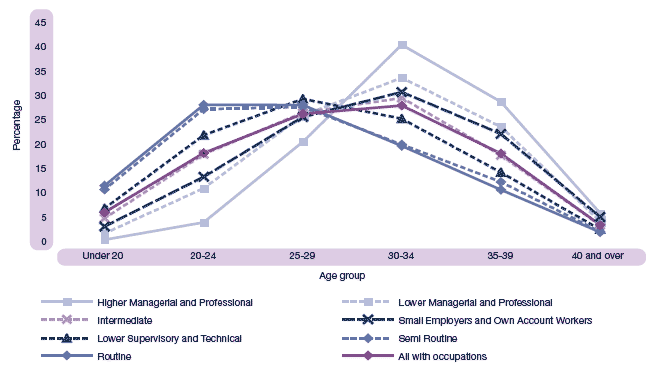
Average age of mother
The trend towards later childbearing may be summarised by considering the average age for all mothers. In 2007, the average was 29.4 compared with 26.1 in 1977, 26.7 in 1987 and 28.7 in 1997. Figure 2.6 shows that, over the last 15 years, the average age of mothers increased by broadly similar amounts for all socio-economic classes. In 2007, the average age ranged from around 28 years for those in the ‘routine’ and ‘semi-routine’ categories to 34 for the ‘higher managerial and professional’ category.
Figure 2.6 Average age of mother, by socio-economic class, Scotland, 1992-2007
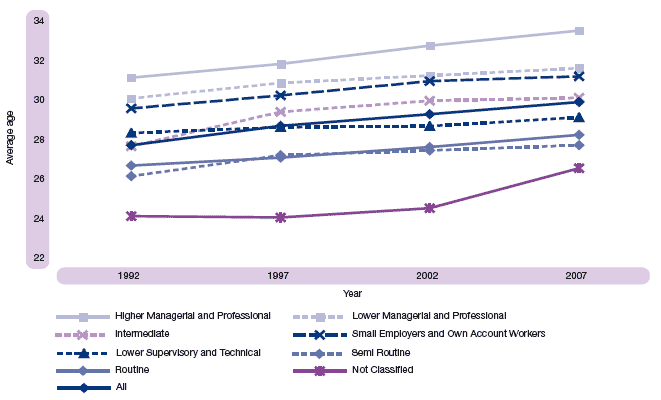
Regional variation
Fertility levels are not uniform across the country. Figure 2.7 shows the 2007 general fertility rates for Council areas. The Scottish rate is 54.8 births for every 1,000 females of childbearing age. Urban areas tend to have a lower birth rate than the Scottish average, e.g. at 43.9 the rate for Edinburgh is 20 per cent below the Scottish average. The reasons for this are complex but may be linked to the large student populations, high female economic activity rates and the higher cost of housing.
The urban hinterlands and the more rural areas, e.g. East Lothian, West Lothian and Aberdeenshire tend to have higher than average rates of fertility. This may be associated with the availability of affordable family housing and lower female economic activity rates. There may also be more specific reasons. For example, the relatively high GFR of 65.4 in Moray will, at least in part, be due to the large number of young families associated with the two Royal Air Force bases there.
Figure 2.7 Live births per 1,000 women age 15-44, by Council area 2007
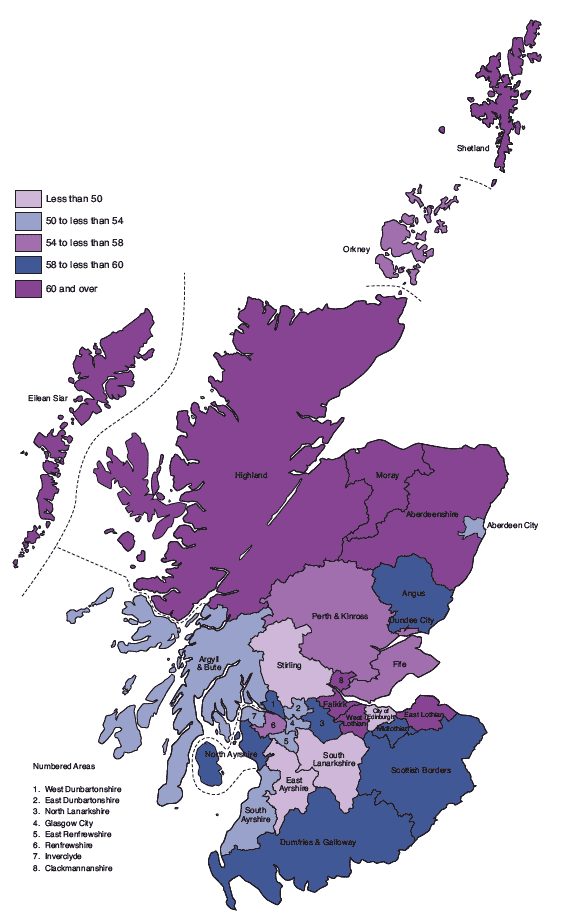
Since 2002 (when the annual number of births began to increase) the GFR has increased from 48.1 to 54.8 births for every 1,000 females of childbearing age, a rise of 14 per cent. Table 2.2 shows the change in GFR at Council level between 2002 and 2007. The GFRs in all Council areas have increased, to a greater or lesser extent. There were increases of more than 20 per cent in six areas – Clackmannanshire (30 per cent), West Dunbartonshire and Falkirk (both 24 per cent) and Shetland, East Lothian and Moray (all 21 per cent). Smaller increases, of less than 10 per cent occurred in five areas – Edinburgh and East Renfrewshire (both 6 per cent), East Dunbartonshire (5 per cent), Stirling (4 per cent) and Argyll and Bute (3 per cent).
Chapter 2 of the 2006 Annual Review focused on local perspectives of Scottish demography and contains a number of tables, charts and maps on regional variation in fertility.
Table 2.2 Number of births and general fertility rate, by Council area, 2002 and 2007
|
Number of births |
General fertility rate (GFR) |
Increase |
||
|---|---|---|---|---|---|
2002 |
2007 |
2002 |
2007 |
||
Scotland |
51,270 |
57,781 |
48.1 |
54.8 |
14% |
Council area |
|||||
Aberdeen City |
2,098 |
2,417 |
43.9 |
52.3 |
19% |
Aberdeenshire |
2,326 |
2,690 |
52.5 |
60.0 |
14% |
Angus |
1,014 |
1,152 |
50.1 |
59.4 |
18% |
Argyll & Bute |
755 |
741 |
48.9 |
50.1 |
3% |
Clackmannanshire |
480 |
634 |
49.3 |
63.9 |
30% |
Dumfries & Galloway |
1,343 |
1,507 |
50.5 |
59.8 |
18% |
Dundee City |
1,436 |
1,668 |
45.1 |
53.8 |
19% |
East Ayrshire |
1,157 |
1,304 |
47.6 |
55.0 |
16% |
East Dunbartonshire |
942 |
892 |
44.6 |
47.0 |
5% |
East Lothian |
910 |
1,101 |
51.4 |
62.1 |
21% |
East Renfrewshire |
916 |
893 |
51.4 |
54.3 |
6% |
Edinburgh, City of |
4,477 |
5,056 |
41.3 |
43.9 |
6% |
Eilean Siar |
242 |
263 |
54.3 |
60.2 |
11% |
Falkirk |
1,507 |
1,892 |
49.5 |
61.2 |
24% |
Fife |
3,536 |
4,076 |
49.0 |
56.7 |
16% |
Glasgow City |
6,386 |
7,154 |
45.8 |
51.2 |
12% |
Highland |
1,977 |
2,332 |
50.8 |
60.0 |
18% |
Inverclyde |
787 |
857 |
45.5 |
53.8 |
18% |
Midlothian |
863 |
937 |
52.2 |
59.2 |
13% |
Moray |
876 |
1,001 |
54.3 |
65.4 |
21% |
North Ayrshire |
1,379 |
1,528 |
49.8 |
57.7 |
16% |
North Lanarkshire |
3,664 |
4,045 |
51.9 |
59.0 |
14% |
Orkney Islands |
164 |
190 |
47.5 |
54.6 |
15% |
Perth & Kinross |
1,245 |
1,391 |
50.0 |
54.5 |
9% |
Renfrewshire |
1,797 |
1,898 |
49.2 |
54.7 |
11% |
Scottish Borders |
1,021 |
1,170 |
51.6 |
59.8 |
16% |
Shetland Islands |
209 |
244 |
50.3 |
60.8 |
21% |
South Ayrshire |
955 |
1,029 |
45.4 |
51.6 |
14% |
South Lanarkshire |
3,076 |
3,452 |
48.5 |
55.3 |
14% |
Stirling |
833 |
878 |
45.7 |
47.6 |
4% |
West Dunbartonshire |
939 |
1,105 |
47.2 |
58.4 |
24% |
West Lothian |
1,960 |
2,284 |
54.6 |
63.7 |
17% |